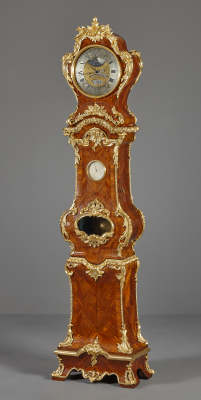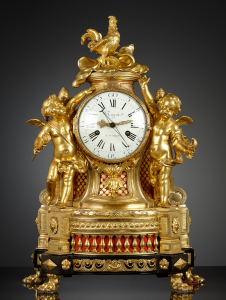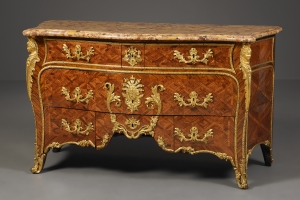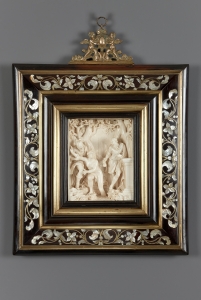French Louis XV regulator longcase clock with equation, Julien Le Roy
French Louis XV regulator longcase clock with equation, Julien Le Roy
A stately longcase clock in an elaborately ornamented and elegantly proportioned kingwood case. The case comprises four segments, being the hood, the waist, the base and the foot. As a whole, the clock is an unmistakeable example of French Rococo from the second quarter of the eighteenth century. The case is elegantly rounded and waisted, and is visually reinforced by the opulent gilt bronzework that seamlessly follows and accentuates the case’s form. The hood contains the round dial and its indicators, behind which is the elaborate and intricate movement. The trunk section contains an unusually large lenticle, above which is a thermometer in the form of an additional small dial. The case is stamped A Dubois.
Adrien Dubois
Records show that Adrien Dubois once worked in Rue du Faubourg Saint-Antoine, starting out as foreman in the prominent workshop founded by Bernard van Risenburgh I (made master before 1722), a specialist in the crafting of clock cases who is better known by his stamp, BVRB. Adrien Dubois lived above the workshop with Bernard and his family, and when Bernard died in 1738, his estate included a very large number of completed and incomplete clocks, clock cases and plinths, many of which were allegedly made by Dubois. In 1741, three years after his master’s death, Adrien himself was finally admitted to the guild as maître ébéniste. In addition to clock cases, Dubois and his family were famous for the restoration and modification of previously created boullework.
Movement
The movement’s plates are interconnected by five tapering pillars. The one-month going train is driven by weights and has a pinwheel escapement. The striking train uses a countwheel and strikes the hours and half hours on a bell with a hammer.
Dial
The eleven-inch round dial is signed Julien Le Roy in the middle. The silvered numeral ring indicates the hours in Roman numerals and the minutes in Arabic numerals. Between the Roman numerals VII and VIII is a sunrise indicator, which functions automatically; sunset is indicated between the numerals IV and V. The gilt and engraved central plate with a trelliswork pattern has three arc-shaped openings. The highest of these is for the moon phase indicator, the middle window shows the date and day of the month, and the lower – located above the numeral VI – contains a zodiac indicator. The two silvered hands indicate the hours and minutes, while a blued steel hand with an engraved sun indicates sunrise and sunset. A fourth hand, also blued steel, serves as a central seconds hand.
Julien Le Roy (1686-1759)
Le Roy’s peers considered him to be perhaps the most influential clockmaker of his time; he was not only an exceptional craftsman, but also a scholar who contributed to the Encyclopédie’s section on timepieces, and was praised by Voltaire as being single-handedly responsible for the superiority of the French clockmaking industry in the eighteenth century.
Born in Tours and trained by his father, Julien Le Roy arrived in Paris around 1700. It is generally assumed that he served as a companion to the Parisian clockmaker Charles Le Bon. Le Roy was admitted to the clockmakers’ guild in 1713, and promptly opened a workshop in Rue de Harlay, near La Place Dauphine, where the most respected Parisian clockmakers of the eighteenth century were established. In 1717, he presented an equation clock to the Royal Academy of Sciences that showed the actual time, the location of the sun, and the sun’s passage. In 1739, Julien Le Roy was appointed valet de chambre, horloger du Roi, and was assigned a workplace in the Louvre, where he subsequently worked in addition to his workshop in Rue de Harlay. Le Roy’s son Pierre (1717-1785) succeeded his father and dedicated the final years of his career to the longitude problem and the development of maritime timepieces.
- Provenance
- Galerie Neuse, Bremen, 1995
Private collection, Amsterdam - Period
- ca. 1745
- Material
- oak cabinet veneered with kingwood and tulipwood, gilt bronze, silvered dial
- Signature
- Julien Le Roy [dial]; A Dubois [case interior]
- Dimensions
- 218 x 55 x 31 cm
Global shipping available










